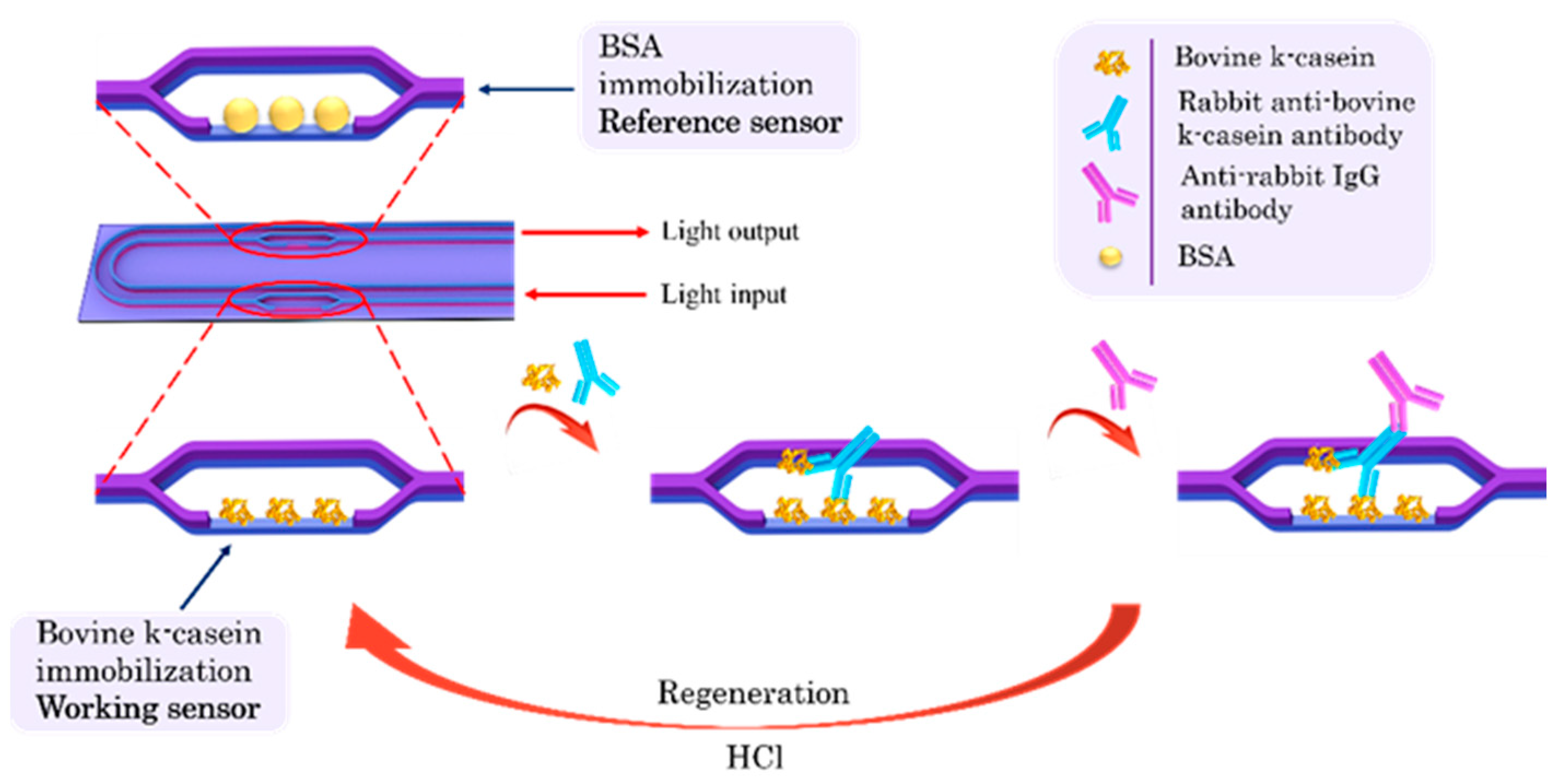Detection of Adulteration of Milk from Other Species with Cow Milk through an Immersible Photonic Immunosensor †
Abstract
1. Introduction
2. Materials and Methods
2.1. Reagents
2.2. Biosensing Principle
2.3. Chemical and Biological Functionalization
2.4. Immunoassay
3. Results and Discussion
3.1. Assay Optimization
3.2. Analytical Characteristics
4. Conclusions
Author Contributions
Funding
Institutional Review Board Statement
Informed Consent Statement
Data Availability Statement
Conflicts of Interest
References
- Montgomery, H.; Haughey, S.A.; Elliott, C.T. Recent food safety and fraud issues within the dairy supply chain (2015–2019). Glob. Food Sec. 2020, 26, 100447. [Google Scholar] [CrossRef] [PubMed]
- European Commission EC 213/2001, Methods for the analysis and quality evaluation of milk and milk products. Off. J. Eur. Comm. 2001, 44, L37/31–L37/99.
- Nagraik, R.; Sharma, A.; Kumar, D.; Chawla, P.; Kumar, A.P. Milk adulterant detection: Conventional and biosensor based approaches: A review. Sens. Biosensing Res. 2021, 33, 100433. [Google Scholar] [CrossRef]
- Li, L.; Wang, J.; Li, M.; Yang, Y.; Wang, Z.; Miao, J.; Zhao, Z.; Yang, J. Detection of the adulteration of camel milk powder with cow milk by ultra-high performance liquid chromatography (UPLC). Int. Dairy J. 2021, 121, 105117. [Google Scholar] [CrossRef]
- Song, H.; Xue, H.; Han, Y. Detection of cow’s milk in Shaanxi goat’s milk with an ELISA assay. Food Control 2011, 22, 883–887. [Google Scholar] [CrossRef]
- Vincent, D.; Elkins, A.; Condina, M.R.; Ezernieks, V.; Rochfort, S. Quantitation and Identification of Intact Major Milk Proteins for High-Throughput LC-ESI-Q-TOF MS Analyses. PLoS ONE 2016, 11, e0163471. [Google Scholar] [CrossRef] [PubMed]
- Nehra, M.; Lettieri, M.; Dilbaghi, N.; Kumar, S.; Marrazza, G. Nano-Biosensing Platforms for Detection of Cow’s Milk Allergens: An Overview. Sensors 2020, 20, 32. [Google Scholar] [CrossRef] [PubMed]
- Sharma, S.; Paliwal, A.; Bassi, M.; Tomar, M.; Gupta, V.; Gulati, S. Investigation of Adulteration in Milk using Surface Plasmon Resonance. ECS J. Solid State Sci. Technol. 2021, 10, 091004. [Google Scholar] [CrossRef]
- Angelopoulou, M.; Makarona, E.; Salapatas, A.; Misiakos, K.; Synolaki, E.; Ioannidis, A.; Chatzipanagiotou, S.; Ritvos, M.A.; Pasternack, A.; Ritvos, O.; et al. Directly immersible silicon photonic probes: Application to rapid SARS-CoV-2 serological testing. Biosens. Bioelectron. 2022, 215, 114570. [Google Scholar] [CrossRef] [PubMed]
- Angelopoulou, M.; Petrou, P.S.; Raptis, I.; Misiakos, K.; Livaniou, E.; Makarona, E.; Kakabakos, S. Rapid detection of mozzarella and feta cheese adulteration with cow milk through a silicon photonic immunosensor. Analyst 2021, 146, 529–537. [Google Scholar] [CrossRef] [PubMed]


| Sample | Amount of Bovine k-Casein Added (μg/mL) | Amount Determined (μg/mL) | Recovery % |
|---|---|---|---|
| Ewe milk | 0.20 | 0.21 | 105.0 |
| 0.60 | 0.57 | 95.0 | |
| 1.50 | 1.55 | 103.3 | |
| Goat milk | 0.20 | 0.19 | 95.0 |
| 0.60 | 0.64 | 106.7 | |
| 1.50 | 1.42 | 94.6 |
Disclaimer/Publisher’s Note: The statements, opinions and data contained in all publications are solely those of the individual author(s) and contributor(s) and not of MDPI and/or the editor(s). MDPI and/or the editor(s) disclaim responsibility for any injury to people or property resulting from any ideas, methods, instructions or products referred to in the content. |
© 2023 by the authors. Licensee MDPI, Basel, Switzerland. This article is an open access article distributed under the terms and conditions of the Creative Commons Attribution (CC BY) license (https://creativecommons.org/licenses/by/4.0/).
Share and Cite
Kourti, D.; Angelopoulou, M.; Misiakos, K.; Makarona, E.; Economou, A.; Petrou, P.; Kakabakos, S. Detection of Adulteration of Milk from Other Species with Cow Milk through an Immersible Photonic Immunosensor. Eng. Proc. 2023, 35, 5. https://doi.org/10.3390/IECB2023-14582
Kourti D, Angelopoulou M, Misiakos K, Makarona E, Economou A, Petrou P, Kakabakos S. Detection of Adulteration of Milk from Other Species with Cow Milk through an Immersible Photonic Immunosensor. Engineering Proceedings. 2023; 35(1):5. https://doi.org/10.3390/IECB2023-14582
Chicago/Turabian StyleKourti, Dimitra, Michailia Angelopoulou, Konstantinos Misiakos, Eleni Makarona, Anastasios Economou, Panagiota Petrou, and Sotirios Kakabakos. 2023. "Detection of Adulteration of Milk from Other Species with Cow Milk through an Immersible Photonic Immunosensor" Engineering Proceedings 35, no. 1: 5. https://doi.org/10.3390/IECB2023-14582
APA StyleKourti, D., Angelopoulou, M., Misiakos, K., Makarona, E., Economou, A., Petrou, P., & Kakabakos, S. (2023). Detection of Adulteration of Milk from Other Species with Cow Milk through an Immersible Photonic Immunosensor. Engineering Proceedings, 35(1), 5. https://doi.org/10.3390/IECB2023-14582











